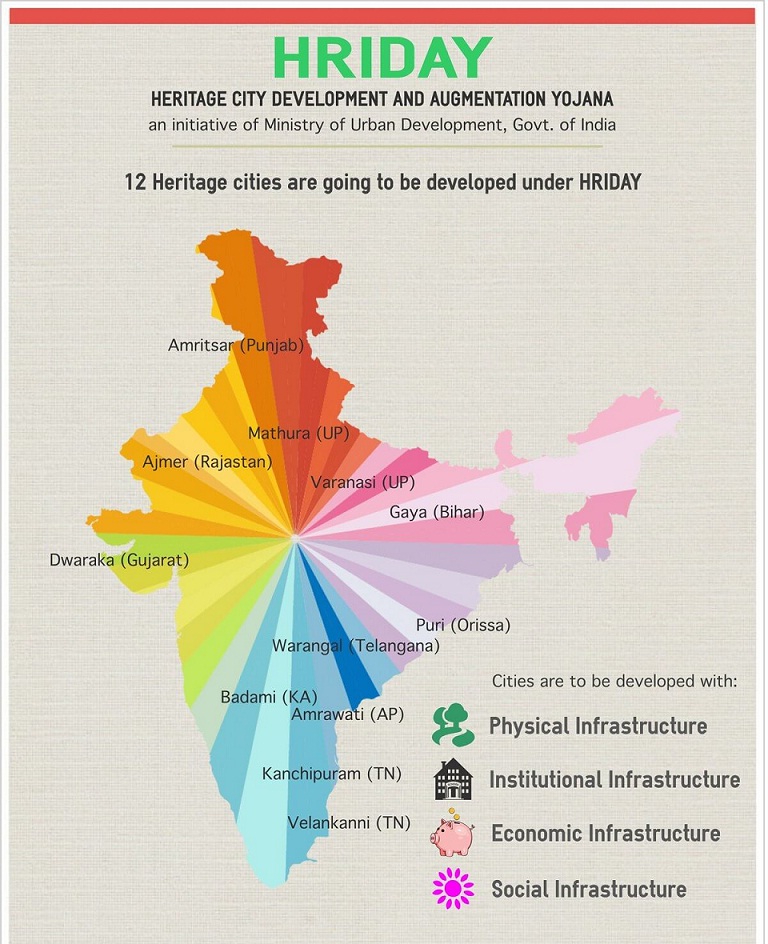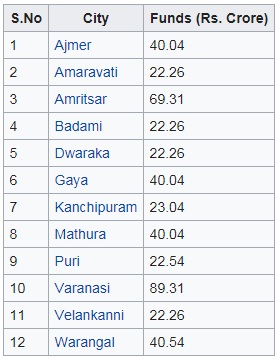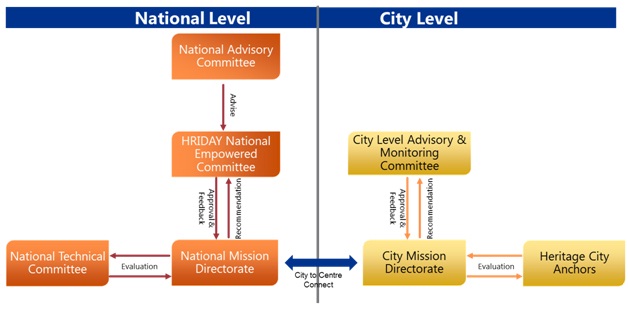





Published on Oct 24, 2018
The Ministry of Housing and Urban Affairs, Government of India, launched the National Heritage City Development and Augmentation Yojana (HRIDAY) scheme on 21st January, 2015, with a focus on holistic development of heritage cities. The scheme aims to preserve and revitalise soul of the heritage city to reflect the city’s unique character by encouraging aesthetically appealing, accessible, informative & secured environment.
With a duration of 4 years (Completing in November, 2018) and a total outlay of INR 500 Crores, the Scheme is being implemented in 12 identified Cities namely, Ajmer, Amaravati, Amritsar, Badami, Dwarka, Gaya, Kanchipuram, Mathura, Puri, Varanasi, Velankanni and Warangal. The scheme is implemented in a mission mode.
The Scheme supports development of core heritage infrastructure projects which shall include revitalization of urban infrastructure for areas around heritage assets identified / approved by the Ministry of Culture, Government of India and State Governments. These initiatives shall include development of water supply, sanitation, drainage, waste management, approach roads, footpaths, street lights, tourist conveniences, electricity wiring, landscaping and such citizen services.
India is endowed with rich and diverse natural, historic and cultural resources. It is a palette of different cultures, religions, traditions, home of various forms of art & handicrafts, music and literature, architectural styles et al. However, it is yet to explore the full potential of such resources to its full advantages.
Past efforts of conserving historic and cultural resources in Indian cities and towns have often been carried out in isolation from the needs and aspirations of the local communities as well as the main urban development issues, such as local economy, urban planning, livelihoods, service delivery, and infrastructure provision in the areas. Heritage areas are neglected, overcrowded with inadequate basic services and infrastructure, such as water supply, sanitation, roads, etc. Basic amenities like toilets, signages, street lights are missing. Multiple institutions and unclear regulatory framework for financing and managing urban heritage assets and landscapes, as well as weak capacity of Urban Local Bodies have created major challenges for managing these heritage cities.

In order to make these cities vibrant, competitive and to address some of stated challenges, a planned approach is necessary for tapping the unlimited potential underlying in tourism and heritage sector unleashing the power of skilful artisans and traditional economy. This will also enable smooth dovetailing of modern concept of local economic development through locally available knowledge, resources and skills. The heritage development of city is not about development and conservation of few monuments, but development of entire city, its planning, its basic services, quality of life to its communities, its economy and livelihoods, cleanliness, security, reinvigoration of its’ soul and explicit manifestation of its character.
With this background, Ministry of Housing and Urban Affairs, Government of India, launched the Heritage City Development and Augmentation Yojana (HRIDAY) scheme, with a focus on holistic development of heritage cities. The scheme aims to preserve and revitalise soul of the heritage city to reflect the city’s unique character by encouraging aesthetically appealing, accessible, informative & secured environment.
HRIDAY strategizes its efforts like planning, development, implementation and management for ensuring the sustainable growth of selected heritage cities in partnership with State Governments. It offers a paradigm shift in India’s approach to city development, bringing together urban planning/economic growth and heritage conservation in an inclusive and integrated manner with special attention on livelihoods, skills, cleanliness, security, accessibility and service delivery. The scheme will work through a partnership of Government (Central/State/Local), private sector, academic institutions and local community, combining affordable technologies.
As a pilot, this flagship scheme of the government focuses on revitalising twelve heritage cities, namely Amrawati (Andhra Pradesh), Gaya (Bihar), Dwaraka (Gujarat), Badami (Karnataka), Puri (Odisha), Amritsar (Punjab), Ajmer (Rajasthan), Kanchipuram and Velankanni (Tamil Nadu), Warrangal (Telangana) and Mathura and Varanasi (Uttar Pradesh).
The scheme will broadly focus on four theme areas i.e. Physical Infrastructure, Institutional Infrastructure, Economic Infrastructure & Social Infrastructure for reviving and revitalizing the soul of Heritage City. Identified cities/towns will be required to prepare Heritage Management Plan (HMP) for the city/town and develop and execute Detailed Project Reports (DPRs) for identified projects (after consultation with all stakeholders) for availing assistance under the scheme, through either empanelled agencies, state para-statals, Public Sector Undertakings, Special purpose vehicles et al.
HRIDAY is a central sector scheme, where 100% funding will be provided by Government of India. The duration of this scheme is four years i.e. from December 2014 to March 2018. The scheme would be implemented in a mission mode.
The main objective of HRIDAY is to preserve character of the soul of heritage city and facilitate inclusive heritage linked urban development by exploring various avenues including involving private sector. Specific objectives are:
Planning, development and implementation of heritage sensitive infrastructure.
Service delivery and infrastructure provisioning in historic city core areas.
Preserve and revitalize heritage wherein tourists can connect directly with city’s unique character.
Develop and document a heritage asset inventory of cities – natural, cultural, living and built heritage as a basis for urban planning, growth and service provision & delivery.
Implementation and enhancement of basic services delivery with focus on sanitation services like public conveniences, toilets, water taps, street lights with use of latest technologies in improving tourist facilities/amenities.
Local capacity enhancement for inclusive heritage-based industry.
Create effective linkages between tourism and cultural facilities and also the conservation of natural and built heritage.
Urban heritage adaptive rehabilitation and maintenance, including appropriate technologies for historic buildings retrofitting.
Establish and manage effective public private partnership for adaptive urban rehabilitation.
Development and promotion of core tangible economic activities to enhance avenues of livelihoods amongst stakeholders. This would also include necessary skill development amongst them including making public spaces accessible and developing cultural spaces.
Making cities informative with use of modern ICT tools and making cities secure with modern surveillance and security apparatus like CCTV etc.
Increase accessibility i.e. physical access (roads as well as universal design) and intellectual access (i.e. digital heritage and GIS mapping of historical locations/ tourist maps and routes).
HRIDAY is a central sector scheme, where 100% funding will be provided by Government of India. INR 500 Crores have been allocated to the scheme, under the following heads:

The scheme would be implemented in a mission mode. Each city has been granted a specific amount of fund, based on its population and size. The funding is as follows

The Scheme is structured for planning and implementation through the following institutional structures:

• HNEC provides overall sanction, approval, guidance and advice to the Scheme. Following are its broad roles and responsibilities:
• Approve all operations and fund release, review and monitor the overall performance of the scheme.
• Approve establishment of City Level Committees and agencies such as CLAMC, HRIDAY City Anchors and City Mission Directorate
• Ensure that there is no duplication in the sanctioning of project/ works/activities/ under HRIDAY and those eligible/sanctioned under other schemes of GOI
• Recommend mid-course correction in the implementation tools as & when required.
The National Mission Directorate is headed by the Mission Director and supported by the National Institute of Urban Affairs which is the designated National Project Management Unit for the Scheme. The NPMU constitutes the following persons:
Urban Planning Specialist
Municipal Engineer
Financial Specialist
Preparation of HRIDAY Guidelines, model RFPs and Toolkits for implementing various components
Overall Program Monitoring, Governance and Fund Management of HRIDAY Scheme
Facilitate selection of HRIDAY City Anchors and setting up of City Mission Directorates
Empanelment of Agencies for DPR preparation, Execution and Third Party Monitoring & Evaluation
Knowledge Transfer on Innovative Ideas and Best Practices across Cities
Capacity Building of HRIDAY stakeholders
The National Technical Committee is convened by the Director, NIUA and consists of the following members:
Mission Director (HRIDAY)
Representatives from Archeological Survey of India (ASI)
Representative from Ministry of Culture
Representative from Ministry of Tourism
Representative from INTACH
Representative from CPWD
Any other Representatives as deemed fit by the Convener
The main purpose of the Technical Committee is to technically review and evaluate implementation frameworks, Detailed Project Reports, City HRIDAY Plans and other such agendas, before it is put forth at the HNEC Meeting.
Support in developing HRIDAY Guidelines, RFPs and Toolkits
Support in selection of agencies or institutions as HRIDAY City Anchors
Support in preparation of City HRIDAY Plan Toolkit and the Final City HP
Support in evaluating the DPRs and its implication